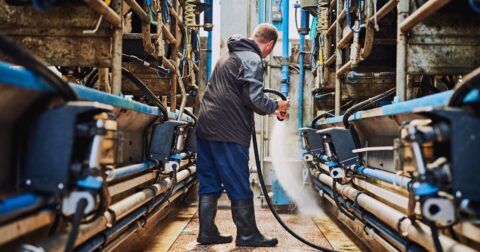Reported
Beagles Are Bred by the Thousands on Factory Farms, and It’s Perfectly Legal
Justice•4 min read
Explainer
Right to farm laws are increasingly used to protect industrial meat operations from answering for their air and water pollution.


Words by Björn Ólafsson
The business of farming is protected in ways that other types of industries in this country don’t enjoy. From crackdowns on journalists (dubbed “ag-gag” laws) to large government subsidies, there are a wide range of regulations and exemptions on the books. One example are so-called “right to farm” laws, which now exist in every U.S. state. Initially designed to protect individual farmers, today they’re increasingly used to protect industrial-scale factory farms against the complaints of their neighbors.
Let’s dive into exactly what Right to Farm laws do, why they matter and why they’re criticized.
There is no single type of Right to Farm law, but different types of regulations all meant to protect the practice of farming. The simplest explanation is that right to farm laws prohibit nuisance lawsuits against farmers, but what qualifies exactly as a nuisance varies from state to state. Examples include loud noises, egregious smells, expanded farming structures and even too much clutter on fields. Each state has different specifications in their Right to Farm laws, with each offering different types of protection.
In the 1970s and 1980s, suburban neighborhoods expanded into rural areas, as a result encroaching on many farms and farming operations. New residents began to complain to authorities about odors and noises, even though the farms were there first. In response, lawmakers proposed protections that safeguarded the preexisting farms, protecting the so-called “right to farm.” The first Right to Farm bill was passed in 1979 in Massachusetts, but today every single U.S. state has some version of these laws.
Over time, Right to Farm laws have become more powerful, protecting against more than complaints about odors and the sounds of animals. Farms today enjoy broad leeway to avoid crackdowns on their sewage and many other kinds of pollution. These types of laws have also become an important tool for supporting agricultural consolidation — protecting the contract farmers who raise animals in industrial operations to satisfy demand for cheap meat.
Most Right to Farm statutes don’t explicitly define what does and does not constitute a “nuisance,” although we can look to past litigation for guidance. While the typical nuisance dispute is between neighbors, Right to Farm lawsuits usually concern a farm-related disturbance like manure odor, the sounds of slaughterhouses, pesticide drift or the appearance of farm buildings.
The exact breadth and depth of the laws vary from state to state, including how the rules define “agricultural operation,” caps on legal damages and how much the Right to Farm statute exempts or limits the right in question.
For example, New York state defines what exactly constitutes a protected farm differently than does Texas. California only exempts agricultural operations from nuisance lawsuits that have been in operation for at least three years and only “if it was not a nuisance at the time it began.”
The legal language used in these regulations can make it confusing to understand, both for citizens and farming operations. The National Agricultural Law Center maintains a breakdown of state-by-state Right to Farm laws.
Food is a critical supply chain for any society. Without food, we starve. According to a publication of the state of Maryland, right to farm laws discourage the nuisance lawsuits that could be used to impede the business of farming and put the community on notice that agriculture is a priority in the state.
Critics of right to farm laws argue that the regulations put too much power in the hands of the large operations that control most of the food produced in this country, and harm local communities in the process.
Right to Farm laws also raise questions about the power of agriculture lobbyists over legislation. According to a 1996 Pulitzer Prize-winning investigation of pig farmers in North Carolina, one hog magnate pushed Right to Farm laws onto local politicians, essentially rewriting the legal code to benefit his farming operation. This is one extreme example of the corporate power many large-scale farming operations wield. Right to Farm laws also unfairly benefit large corporations, who can afford legal representation to assert their rights, over smaller farms.
Critics of Right to Farm laws also argue that adding right-to-farm laws to state constitutions elevates agricultural rights to a higher status, equivalent to the right to free speech and right to religion. No other for-profit industry is afforded this level of protection.
Agricultural operations face little environmental oversight in the U.S. For example, factory farms and large animal feeding operations are not obligated to treat manure, and are instead allowed to dump the untreated waste in nearby fields. Not only does this create a horrific smell for neighboring communities, but it can also pollute waterways and soil. Homes near concentrated animal feeding operations (CAFOs) can fall in value by up to 88 percent, leaving families stranded and unable to move. Right to Farm laws thwart lawsuits to change these conditions, leaving many families essentially trapped near large-scale animal operations.
If you are interested in reforming Right to Farm laws in the U.S., speak with your state’s elected officials. Citizen organization can be one of the most important tools in creating agricultural reform.